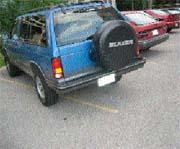
Parking scenes like this have been common on campus these first two weeks, while students battle over unrestricted spaces. With parking space at a premium, Lawrence University’s parking policy has changed in several areas. (Julien Poncet)
When students returned to campus this year, they found some changes in the parking policy.Both the cost of a parking permit and the location of student parking changed over the summer months.
The price of parking permits, which had not gone up in the past five or six years, according to Vince Maas, director of campus services, was raised from $35 a term for on-campus and $25 a term for parking in the city’s east ramp to $50 dollars per term in either location.
Maas said that a proposal had been put forward to make the on-campus parking “premium parking,” and thus more expensive than the city ramp, but the Lawrence University Community Council student welfare committee decided that all parking should cost the same.
Jacques Hacquebord, LUCC president, said that the council made decisions last spring regarding campus parking when the issue was raised.
At issue was the fact that the school was actually losing money on the arrangement with the city of Appleton for the use of the east ramp by charging only $25 per term. The school felt that the arrangement was a good one for the students and felt that asking them to foot more of the bill was reasonable.
According to Hacquebord, the school still has to pay a considerable sum to the city, but it should be significantly lessened with the increased parking fees.
With the increase in fees for the city ramp, LUCC members felt they would have to raise the on-campus parking fee as well.
As Hacquebord noted, parking on campus is at a premium and if the ramp were a more costly alternative to on campus parking, the situation would likely worsen.
As school administrators have pointed out in memoranda, the east ramp provides what they feel to be a reasonable alternative to on-campus parking.
Hacquebord echoed some of the same sentiments when he noted that both parking locations have their advantages.
“While on campus parking might be closer, [The city ramp] allows people to park under cover [and] always find a parking spot,” he said, noting that finding a spot on campus is not always possible.
Lawrence students and faculty also noticed a change in designation of certain lots. Some lots that had previously been student parking, such as the small strip of parking on the west side of Colman Hall, are now designated as faculty and staff lots. The Plantz Hall lot has been split between student and faculty/staff parking.
Maas stated that with the addition of the Hiett Hall student parking lot, certain changes needed to be made so as to rebalance the number of student and faculty/staff parking spots.
Maas added that with the construction of Hiett Hall, “the faculty lost about 70 spots.” He noted that the reconfigured parking situation tries to get students close to Hiett Hall while evening out the numbers by giving the faculty some of the spots previously reserved for student parking.
